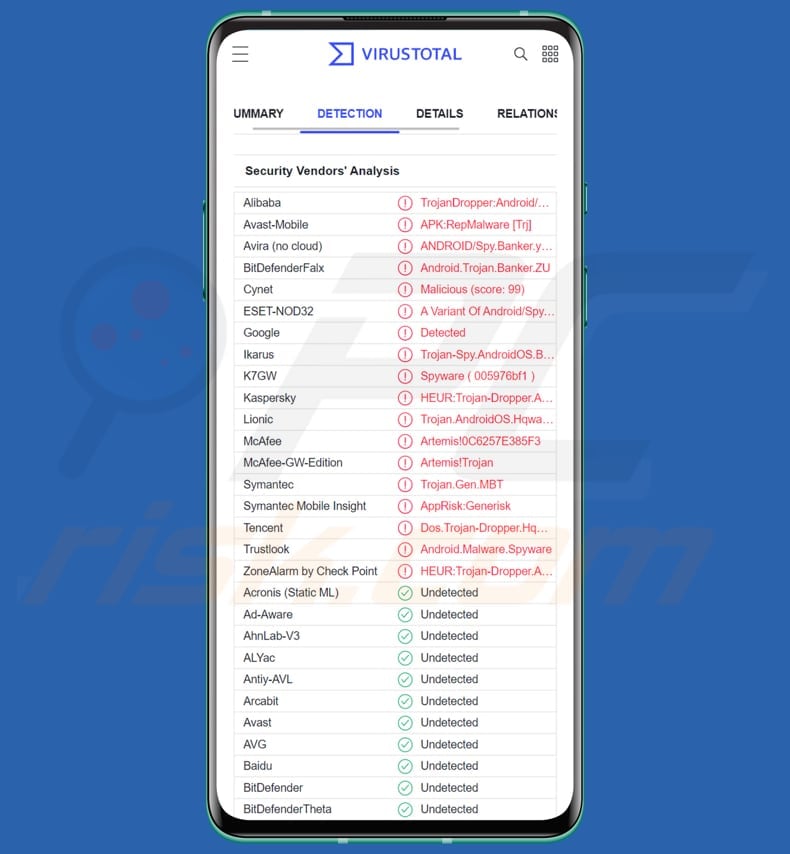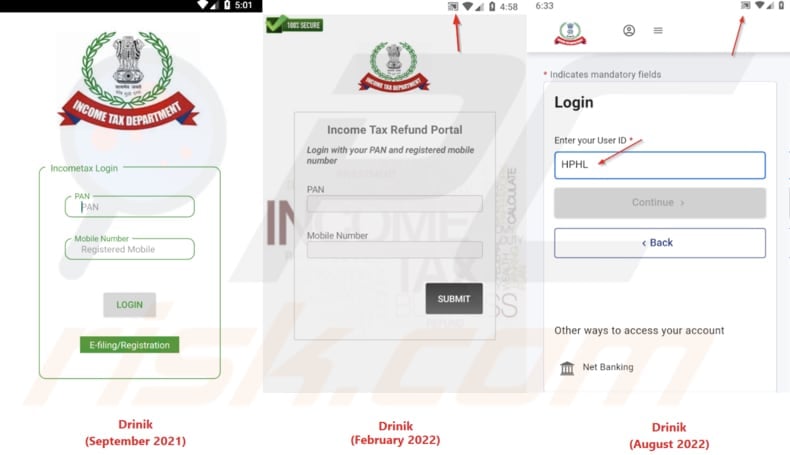Get free scan and check if your device is infected.
Remove it nowTo use full-featured product, you have to purchase a license for Combo Cleaner. Seven days free trial available. Combo Cleaner is owned and operated by RCS LT, the parent company of PCRisk.com.
What kind of malware is Drinik?
Drinik is the name of an Android malware that previously functioned as an SMS stealer that has now evolved into a banking Trojan. There are at least three variants of Drinik malware. The latest one can record the victim's screen, harvest credentials, log keystrokes and manage incoming calls.

Drinik malware in detail
The first Drinik version steals banking credentials using a phishing website. The second variant steals those credentials using screen recording and a phishing technique. The latest one steals login credentials using keylogging and screen recording features. The third Drinik variant opens the official income tax department page to steal login credentials.
The newest Drinik variant masquerades as an application called iAssist. That app mimics the tax management tool of the Income Tax Department of India. The malicious iAssist app requests permissions to send and receive SMS messages, access phone messages, read call logs, and read from and write to external storage.
This Drinik version relies on the Accessibility Service. Once abuses this service to record screen, disable Google Play Protect, capture keystrokes, and execute auto-gestures. Unlike older versions, the newest Drinik version opens the official Indian income tax website (older versions displayed phishing websites).
At first, Drinik displays an authentication screen for biometric verification. Once the PIN is entered, Drinik uses screen recording to steal the PIN and captures keystrokes. When the authentication is completed, Drinik loads the official Indian income tax website.
Then it sends the entered User ID and other login information that the victim is requested to enter to the Command and Control (C2) server. After successful login, Drinik shows a fake message stating that the victim is "eligible for an instant tax refund". That message instructs the victim to click the "Apply" button to apply for instant refund.
Once the "Apply" button is clicked, Drinik opens a phishing website masquerading as the Income Tax Department of India page. On that page, visitors are requested to provide their full name, Aadhar number, PAN number, account number, credit card number, CVV, PIN, and other sensitive information. All entered details are sent to the C2 server.
After entering the information mentioned above, Drinik displays another page (the confirmation website) requesting to verify Income Tax Details using banking credentials.
| Name | Drinik banking Trojan |
| Threat Type | Android malware, banking Trojan |
| Detection Names (iAssist.apk) | Avast-Mobile (APK:RepMalware [Trj]), BitDefenderFalx (Android.Trojan.Banker.ZU), ESET-NOD32 (A Variant Of Android/Spy.Banker.BLC), Kaspersky (HEUR:Trojan-Dropper.AndroidOS.Hqwar.bk), Full List (VirusTotal) |
| Related IP Address | 192.227.196.185 |
| Symptoms | The device is running slow, system settings are modified without user's permission, questionable applications appear, data and battery usage is increased significantly, browsers redirect to questionable websites, intrusive advertisements are delivered. |
| Distribution methods | SMS, social engineering, deceptive applications, scam websites. |
| Damage | Stolen personal information (private messages, logins/passwords, etc.), decreased device performance, battery is drained quickly, decreased Internet speed, monetary losses, stolen identity. |
| Malware Removal (Windows) |
To eliminate possible malware infections, scan your computer with legitimate antivirus software. Our security researchers recommend using Combo Cleaner. Download Combo CleanerTo use full-featured product, you have to purchase a license for Combo Cleaner. 7 days free trial available. Combo Cleaner is owned and operated by RCS LT, the parent company of PCRisk.com. |
More about Drinik malware
Additionally, this malware abuses the Accessibility Service to steal sensitive information. It checks the sources of events that trigger the Accessibility Service for bank keywords. It can also abuse this service to allow or disallow incoming calls (without the victim's knowledge).
Drinik is an evolving Android malware that may be upgraded in the future (it may have additional capabilities, new targets, and techniques to target victims).
How did Drinik infiltrate my device?
It is known that one of the fake apps used to distribute Drinik is called iAssist. Threat actors use SMS to trick users into downloading and installing this app. They send an SMS with an APK file. In other cases, cybercriminals use Google Play and third-party stores, shady websites, and email to distribute Android malware.
How to avoid installation of malware?
Download applications from legitimate sources (official stores and pages). Always read reviews before downloading apps (do not trust apps with no or few reviews). Keep the operating system and installed apps updated. Use a reputed antivirus software for protection. Make sure that Google Play Protect is always enabled on Android devices.
Do not click links or open files received via SMS or email when received messages/letters are irrelevant or suspicious in other ways.
Appearance of different Drinik variants (source: cyble.com):

Screenshots of the fake Tax Deparment of India website (source: cyble.com):
Quick menu:
- Introduction
- How to delete browsing history from the Chrome web browser?
- How to disable browser notifications in the Chrome web browser?
- How to reset the Chrome web browser?
- How to delete browsing history from the Firefox web browser?
- How to disable browser notifications in the Firefox web browser?
- How to reset the Firefox web browser?
- How to uninstall potentially unwanted and/or malicious applications?
- How to boot the Android device in "Safe Mode"?
- How to check the battery usage of various applications?
- How to check the data usage of various applications?
- How to install the latest software updates?
- How to reset the system to its default state?
- How to disable applications that have administrator privileges?
Delete browsing history from the Chrome web browser:

Tap the "Menu" button (three dots on the right-upper corner of the screen) and select "History" in the opened dropdown menu.

Tap "Clear browsing data", select "ADVANCED" tab, choose the time range and data types you want to delete and tap "Clear data".
Disable browser notifications in the Chrome web browser:

Tap the "Menu" button (three dots on the right-upper corner of the screen) and select "Settings" in the opened dropdown menu.

Scroll down until you see "Site settings" option and tap it. Scroll down until you see "Notifications" option and tap it.

Find the websites that deliver browser notifications, tap on them and click "Clear & reset". This will remove permissions granted for these websites to deliver notifications. However, once you visit the same site again, it may ask for a permission again. You can choose whether to give these permissions or not (if you choose to decline the website will go to "Blocked" section and will no longer ask you for the permission).
Reset the Chrome web browser:

Go to "Settings", scroll down until you see "Apps" and tap it.

Scroll down until you find "Chrome" application, select it and tap "Storage" option.

Tap "MANAGE STORAGE", then "CLEAR ALL DATA" and confirm the action by taping "OK". Note that resetting the browser will eliminate all data stored within. This means that all saved logins/passwords, browsing history, non-default settings and other data will be deleted. You will also have to re-login into all websites as well.
Delete browsing history from the Firefox web browser:

Tap the "Menu" button (three dots on the right-upper corner of the screen) and select "History" in the opened dropdown menu.

Scroll down until you see "Clear private data" and tap it. Select data types you want to remove and tap "CLEAR DATA".
Disable browser notifications in the Firefox web browser:

Visit the website that is delivering browser notifications, tap the icon displayed on the left of URL bar (the icon will not necessarily be a "Lock") and select "Edit Site Settings".

In the opened pop-up opt-in the "Notifications" option and tap "CLEAR".
Reset the Firefox web browser:

Go to "Settings", scroll down until you see "Apps" and tap it.

Scroll down until you find "Firefox" application, select it and tap "Storage" option.

Tap "CLEAR DATA" and confirm the action by taping "DELETE". Note that resetting the browser will eliminate all data stored within. This means that all saved logins/passwords, browsing history, non-default settings and other data will be deleted. You will also have to re-login into all websites as well.
Uninstall potentially unwanted and/or malicious applications:

Go to "Settings", scroll down until you see "Apps" and tap it.

Scroll down until you see a potentially unwanted and/or malicious application, select it and tap "Uninstall". If, for some reason, you are unable to remove the selected app (e.g., you are prompted with an error message), you should try using the "Safe Mode".
Boot the Android device in "Safe Mode":
The "Safe Mode" in Android operating system temporarily disables all third-party applications from running. Using this mode is a good way to diagnose and solve various issues (e.g., remove malicious applications that prevent users you from doing so when the device is running "normally").

Push the "Power" button and hold it until you see the "Power off" screen. Tap the "Power off" icon and hold it. After a few seconds the "Safe Mode" option will appear and you'll be able run it by restarting the device.
Check the battery usage of various applications:

Go to "Settings", scroll down until you see "Device maintenance" and tap it.

Tap "Battery" and check the usage of each application. Legitimate/genuine applications are designed to use as low energy as possible in order to provide the best user experience and to save power. Therefore, high battery usage may indicate that the application is malicious.
Check the data usage of various applications:

Go to "Settings", scroll down until you see "Connections" and tap it.

Scroll down until you see "Data usage" and select this option. As with battery, legitimate/genuine applications are designed to minimize data usage as much as possible. This means that huge data usage may indicate presence of malicious application. Note that some malicious applications might be designed to operate when the device is connected to wireless network only. For this reason, you should check both Mobile and Wi-Fi data usage.

If you find an application that uses a lot of data even though you never use it, then we strongly advise you to uninstall it as soon as possible.
Install the latest software updates:
Keeping the software up-to-date is a good practice when it comes to device safety. The device manufacturers are continually releasing various security patches and Android updates in order to fix errors and bugs that can be abused by cyber criminals. An outdated system is way more vulnerable, which is why you should always be sure that your device's software is up-to-date.

Go to "Settings", scroll down until you see "Software update" and tap it.

Tap "Download updates manually" and check if there are any updates available. If so, install them immediately. We also recommend to enable the "Download updates automatically" option - it will enable the system to notify you once an update is released and/or install it automatically.
Reset the system to its default state:
Performing a "Factory Reset" is a good way to remove all unwanted applications, restore system's settings to default and clean the device in general. However, you must keep in mind that all data within the device will be deleted, including photos, video/audio files, phone numbers (stored within the device, not the SIM card), SMS messages, and so forth. In other words, the device will be restored to its primal state.
You can also restore the basic system settings and/or simply network settings as well.

Go to "Settings", scroll down until you see "About phone" and tap it.

Scroll down until you see "Reset" and tap it. Now choose the action you want to perform:
"Reset settings" - restore all system settings to default;
"Reset network settings" - restore all network-related settings to default;
"Factory data reset" - reset the entire system and completely delete all stored data;
Disable applications that have administrator privileges:
If a malicious application gets administrator-level privileges it can seriously damage the system. To keep the device as safe as possible you should always check what apps have such privileges and disable the ones that shouldn't.

Go to "Settings", scroll down until you see "Lock screen and security" and tap it.

Scroll down until you see "Other security settings", tap it and then tap "Device admin apps".

Identify applications that should not have administrator privileges, tap them and then tap "DEACTIVATE".
Frequently Asked Questions (FAQ)
What are the biggest issues that malware can cause?
Identity theft, data loss, monetary loss, additional infections, loss of access to online accounts, and similar issues.
What is the purpose of Drinik malware?
Drinik is a banking Trojan targeting Indian banks. It steals sensitive banking-related information such as User ID, full name, Aadhar number, PAN number, account number, credit card number, CVV, PIN, and other information. Also, it can access call logs, block or allow incoming calls, and more.
How did Drinik malware infiltrate my device?
Threat actors distribute Drinik malware by sending SMS containing a malicious APK file. In other cases, threat actors use legitimate or third-party stores, email, and similar methods to lure users into downloading (and executing) malware.
Will Combo Cleaner protect me from malware?
Yes, Combo Cleaner can detect and remove almost all known malware. Usually, high-end malware hides deep in the operating system. Therefore, victims must run a full system scan to detect and remove malware of this kind.
Share:

Tomas Meskauskas
Expert security researcher, professional malware analyst
I am passionate about computer security and technology. I have an experience of over 10 years working in various companies related to computer technical issue solving and Internet security. I have been working as an author and editor for pcrisk.com since 2010. Follow me on Twitter and LinkedIn to stay informed about the latest online security threats.
PCrisk security portal is brought by a company RCS LT.
Joined forces of security researchers help educate computer users about the latest online security threats. More information about the company RCS LT.
Our malware removal guides are free. However, if you want to support us you can send us a donation.
DonatePCrisk security portal is brought by a company RCS LT.
Joined forces of security researchers help educate computer users about the latest online security threats. More information about the company RCS LT.
Our malware removal guides are free. However, if you want to support us you can send us a donation.
Donate



▼ Show Discussion